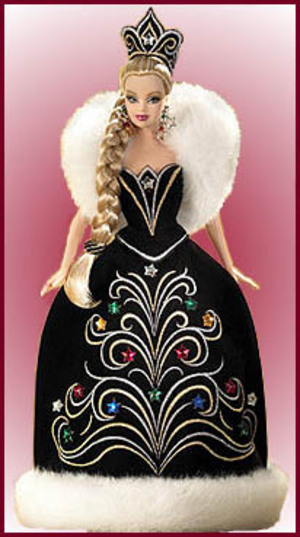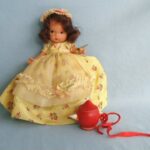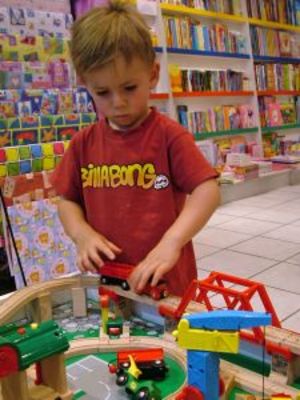Rather than creating licensed toys from established television shows and current movies, the 80s saw the reverse. New toys began spawning television series and movies. The 80s also saw the beginning of crazed Christmas shopping with the first huge toy that could not be found anywhere – Cabbage Patch Kids.
Top Ten Toys of Yesterday: 1980s:
1. Cabbage Patch Kids
No doll in history had ever hit the home run that Cabbage Patch Kids did the year they were introduced in the market (1983). The best way to describe it to the younger generation is to say that it was similar to what happened when Tickle Me Elmo came on the market, but without the EBay resellers.
Although over three million dolls were made, they quickly sold out. Replenishing the shelves just did not happen as each new doll was already spoken for. I remember Cabbage Patch Kids’ first Christmas. My mother happened to be at Toys R Us the day they first sold out of the dolls and was one of the first people on the list to receive them whenever the store could get more. They were on back orders of back orders, but when those few dolls got to the store before Christmas, my mother was able to get one for my youngest sister because she was so high up on the list.
Creator Xavier Roberts first made the dolls in 1977 to pay his way through college. In 1982, Original Appalachian Artworks, Inc. produced the dolls for the larger market.
Cabbage Patch Kids may not be the sensation they were when they first hit the market, but they have proved their longevity and continue to bring enjoyment to children around the world.
Two friends, living in Montreal, sat down to play a game of Scrabble. As their game was missing several pieces, they began innocently talking about inventing their own game. The conversation grew until they were actually creating a game. Those Canadians were Chris Haney and Scott Abbott.
They partnered with two other friends, Chris’ brother John and Ed Werner, a lawyer. They named themselves the Horn Abbot Company. To raise their initial funding, they sold five shares in their company for one thousand dollars each. They gave five shares to the young artist, Michael Wurstlin, for creating the artwork.
The company had the name Trivial Pursuit trademarked and produced one thousand and one hundred copies of the game. Canadian sales began in 1981 and at a significant loss of sixty dollars per game.
Two years later, licensing was given to the US manufacturer, Selchow and Righter who’s successful marketing campaign made Trivial Pursuit a household name.
In one year, twenty million games were sold, and one of those was to my parents for my Christmas present.
Games Magazine named Trivial Pursuit to the Games Hall of Fame in 1993. To date, almost one hundred million games have been sold in twenty-six Countries and seventeen languages.
3. My Little Pony
I cannot read the words “My Little Pony” without the commercial jingle going through my head. My oldest daughter was a huge fan of the television show which came out as a result of the toy’s success.
My Little Pony was invented by Bonnie Zacherle, Charles Muenchinger and Steven D’Aguanno. Hasbro produced the toy and My Little Pony debuted in 1982.
Even though My Little Pony is still marketed and sold for children, there are hundreds of adult collectors who keep the line in business.
4. Koosh Balls
Even though I’d heard about Koosh Balls in the 80s, it was not until The Rosie O’Donnell Show in the 90s that I came to actually buy one. Rosie would often throw Koosh Balls into the audience and when I saw her playing with the Koosh Launcher, I had to have one. It sits in the drawer next to my bed and I pull it out a few times a year to play with it still. For those who often wonder why companies give free stuff to celebrities, that is one example of why it works sometimes better than commercials.
Engineer, Scott Stillinger, tied rubber bands together to make a ball that would be easy for his children to hold and throw. The name came from the sound the ball makes when it lands.
Koosh Balls are unique in that they are made from approximately two thousand rubber filaments tied around the core unlike other balls which had smooth outside surfaces.
Stillinger’s brother-in-law, Mark Button, was a marketing manager for Mattel at the time and joined him to open their own business – Oddz On Products in 1987. One of the hottest toys of the 1988 Christmas season was this new and interesting ball.
Millions of Koosh Balls have been sold and approximately forty percent were purchased for adults to play with. I am one of those adults!
5. Transformers
Hasbro, the creators of the very first action figure, brought new depth to the toy category when they released The Transformers in 1984. Their advertising jingle said that there was “More than meets the eye” and there was. Children could manipulate this new toy robot into a functioning toy car.
Hasbro successfully entrenched the brand into modern culture by creating story lines with battles and gave their robots personalities. That marketing plan spawned a television series, a movie and comic books.
When Hasbro bought the rights to several brands of changing robots in Japan, the Japanese toy manufacturer, Takara jumped on the opportunity and signed with Hasbro to partner the development of new Transformers products.
The original twenty-one toys have become known as Generation One. The very next year, Hasbro released the second group of Transformers toys – Dinobots and Constructicons. Constructicons were the first Transformers that could be combined to make a larger robot.
The huge staying power of this brand is evidenced in the recently released Transformers movie, the second major motion picture highlighting the brand.
6. Pictionary
Hasbro had another huge hit when it released the charades on paper game, Pictionary in 1987. The game was so much fun that a television game show (90s) was produced based on the game. Two teams, each a mixture of celebrities and contestants, competed using a large display easel, presentation board paper and magic markers.
7. Teenage Mutant Ninja Turtles
The Teenage Mutant Ninja Turtles explosion began as a comic book, then on to action figures and a television series, and later even movies. The phenomenon has been recently resurfaced and faithful fans were rewarded with a new major motion picture.
Friends, Kevin Eastman and Peter Laird, were amusing each other with cartoon sketches one evening in 1983. As they were goofing around together, Kevin drew a turtle with nunchuks strapped to its arm. Peter is credited with jokingly saying “Why not a teenage mutant ninja turtle?”
Because the pair loved the idea so much, they decided to create a comic book for their own amusement. The Teenage Mutant Ninja Turtle became four turtles and their sensei would be a mutated rat.
Around the time that they finished their comic book, Eastman had just received an income tax refund for five hundred dollars. The pair borrowed another seven hundred from Eastman’s uncle and self-published three thousand black and white copies.
Eastman and Laird bought a one page advertisement in the Comics Buyer’s Guide, a comic book newspaper. Expecting to sell individual copies through that ad, they were shocked when the calls the did get were from distributors wishing to buy in quantity to resell.
To further their joke, they named themselves Mirage Studios as the idea that the small apartment they worked from was a studio could only be explained as a mirage.
Whether coming up with a press kit was another part of the joke or an intentional attempt at marketing, Laird’s newspaper experience allowed him to develop a real press kit for their new studio’s opening and comic book. They sent this press kit to one hundred and eighty television and radio stations, the Associated Press and the United Press International. Several local newspapers ran stories and PBS radio aired a five minute story. Unbelievably, a United Press International reporter wrote a story that was picked up by newspapers all across the Country.
As a result, all three thousand issues sold out fast. The two printings which followed also sold out, first fifteen thousand copies and then thirty-five thousand copies. Thus begins the Country’s obsession with Michealangelo (their spelling), Raphael, Donatello and Leonardo. Both guys had studied art history, which inspired the names of their characters.
Mark Freedman, a licensing agent, contacted Eastman and Laird in an effort to help them find a company to make action figures of their characters. Freedman connected Mirage with the small toy company, Playmate Toys. Playmate Toys would only agree to the deal if a television deal could be obtained. A mini-series was created in 1987 and proved the characters’ overall appeal and the action figures became just another piece of the Teenage Mutant Ninja Turtle franchise.
8. Chia Pets
Chia Pets are a result of repackaging a product and making it available to a large audience. Animal figures that grow “fur” came from south of the border. Joseph Enterprises Inc. simply trademarked the name and advertised.
The President of the company was at a retail trade show and asked a store owner what product did the best in his store during the Christmas season. That store owner told him about Chia Pets and how much it cost him to get them from the Mexican distributor. The President of Joseph Enterprises was intrigued and visited both the distributor and maker. He learned that the distributor had been charging too high a percentage and he decided to import them directly from the maker. His marketing campaign is famous, “Ch-Ch-Ch-Chia” rings from televisions everywhere.
The first Chia Pet was a ram and was introduced in 1982.
9. JENGA
Swahili for “to build,” JENGA was officially introduced to the United States by Milton Bradley in 1987.
Oxford University student, Leslie Scott, created the game in the early 70s. She and her friends had been playing the game for six years before they were able to convince her to sell it in the United Kingdom. Having spent her childhood in Africa, one of the languages she spoke was Swahili and thus the name.
American, Robert Grebler imported the game to the United States and Canada. In February 1985, Grebler set up a JENGA fund-raising tournament for the Heart Foundation. The public and media response to that tournament resulting in Milton Bradley obtaining the rights to the game.
10. All Terrain Armored Transport (Star Wars Walker)
When The Empire Strikes Back was released in 1980, two walkers were introduced – the All Terrain Armored Transport (AT-AT) and the All Terrain Scout Transport (AT-ST). Both walkers entered the world of Star Wars merchandise, but the All Terrain Armored Transport broke the record as being the most expensive toy ever the year it was introduced.
Walkers were fictional vehicles from Star Wars movies. They walked on the ground using mechanical legs.
The All Terrain Armored Transport was a very large, four-legged walker first introduced during the Battle of Hoth in The Empire Strikes Back. It was also used during in Return of the Jedi.




